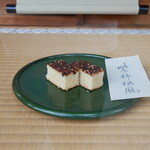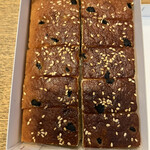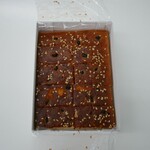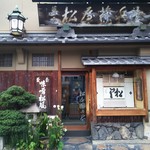
松屋藤兵衛
Matsuyatoubee ◆ まつやとうべえ
3.60
Takaragaike, Kitayama
「Japanese Sweets」
--
--
Opening hours: 9:00-18:00 Open Sundays
Rest time: Thursday Business hours and holidays are subject to change, so please check with the store before visiting.
京都府京都市北区紫野門前
Photos
(20)




















Details
Reservation Info
can be reserved
Payment Method
No credit cards
Electronic money is not accepted
Number of Seats
(No eat-in)
Private Dining Rooms
None
Smoking and Non-Smoking
No smoking at the table
Parking
None
Facilities
Calm space
Comments
(20)
カフェモカ男
3.60
I visited "Matsuya Tohyohei" located in Kita-ku, Kyoto. The shop has a distinct sense of tradition and is easy to find near the "Daikokuji-mae" traffic light. It takes about 15 minutes to walk from Kitaoji Station on the Karasuma Line, so taking a bus might be more convenient. The interior of the shop, like the exterior, exudes a sense of history. Decorative items resembling molds for traditional Japanese sweets were displayed. This long-established confectionery shop was founded in the Edo period. I purchased the "Shinomatsukaze" here. It is made from wheat flour, sugar, malt syrup, white miso, Daikokuji natto, and white sesame. When you put it in your mouth, the flavor of miso comes first, followed by the taste of natto, white sesame, and a sweetness similar to castella cake. The center has a significant hollow space, so I thought it would be best enjoyed with tea. Thank you for the meal.




floristinlilie
4.50
This time, I purchased it as a Mother's Day gift. The consistent appearance and attentive customer service. Inside the glass display, there were seasonal flowers arranged, and I felt their thoughtful consideration. The Miso Matsukaze is gone, which is my father's favorite, and when I delivered it to my mother, I also offered it at the family altar. Thank you for always watching over us, I said.



yuiyui 512
4.00
I bought this as a Mother's Day gift this time. The store is beautifully decorated with seasonal flowers. The taste is consistently delicious as always. It has an elegant and gentle sweetness with the added accent of the saltiness from the Datokuji Natto. It's a truly heartwarming flavor. The staff at the store are also very kind, and they offer options for both personal use and gifts. In addition, they also have items like portable shiruko and wheat gluten senbei called "Funoyaki".



あきぴあの
3.50
I strolled around Daikakuji Temple and on my way back, I stopped by a charming traditional Japanese sweets shop for some souvenirs. The shop had a nostalgic Showa-era vibe, which is typical of Kyoto. I bought "Matsukaze" and "Sazareishi" sweets to take home. It was my first time trying Matsukaze, which I occasionally see in magazines or online. It had a miso flavor with a hint of sweetness. It seemed like the Daikakuji natto was used as an accent, but since I haven't tried others, I couldn't really tell the difference. Overall, I was satisfied with the treats from this shop that has been in business for over 200 years.




じゃんく
3.70
Special opening of Sanmon-in at Daitoku-ji Temple. It is the temple where Ishida Mitsunari and Furuta Oribe are enshrined. After enjoying various things, I returned to the Daitoku-ji-mae bus stop. It is a cool-looking traditional Japanese sweets shop. I bought the famous Daitoku-ji natto-filled Matsukaze, the smallest size, and one bag of sweets. The Matsukaze I had in Hokkaido or somewhere else had a biscotti-like texture, but I wonder how it is in the original Kyoto? It has thickness and density, with a chewy texture like Saga's boron. Sesame seeds and Daitoku-ji natto are sprinkled on the surface, with a strong aroma of sesame and miso. The Daitoku-ji natto is a salty grain. I thought it would be sweet (・_・; The balance of miso and Daitoku-ji natto's saltiness with the slight sweetness of the dough is excellent. This is delicious. I thought it was a caramelized rock, but it seems to be made with egg white, sugar, and ginger. Therefore, it has the texture of caramel and the taste of ginger sugar, a splendid collaboration. Not too sweet, not too hard. I bought it on a whim, like a cheap snack, but this is amazing. The cost of ingredients has increased, so the price has gone up since the reviews from 2-3 years ago, but it is still quite cheap for traditional Japanese sweets. I didn't buy the Tamatama Orihime, thinking I didn't need it, but it seems to be a dried confectionery with a different taste for each color, so I should have bought it (´°̥̥̥̥̥̥̥̥ω°̥̥̥̥̥̥̥̥`). The establishment year is unknown, but it has been around for about 250 years. So is it a Hyakumikai? I looked it up, and Matsukaze is actually from a different shop called Matsuya Tokiwa. Tokiwa was founded in the Joo era, the next era after Jokyu...oh! Around the time of Hojo Yoshitoki's death ∑(゚Д゚) Next time, let's go there too. Let's compare Matsukaze〜♡ Just a side note. Matsukaze 10 pieces (for home use) 1050, Sazareishi 450.




ゆっきょし
3.40
First Visit 202302 (No.4258)
1. Purpose of Visit
- Visited the shop recommended by MyRebi's "Uko"
2. Shop Information
- Genre on Tabelog: Japanese sweets
- The shop has been around for about 250 years
- One of the "Matsukaze" of Kyoto
- Business hours: 09:00-18:00
- Closed on Thursdays
- Takeout only
- Other "Matsukaze" establishments include "Matsuya Tokiwa" founded during the Shoou era (1652-1655) and "Kameya Mutsu" founded in the Oei era (1421)
3. Crowdedness on the day of visit
- Visited around 09:50 on a weekday with no other customers
4. Customer Service
- Polite and attentive service
5. Purchased Item
- Murasakino Matsukaze (10 pieces) for 980 yen
- This "Matsukaze" is made by adding candy made from wheat flour, sugar, and malt to the dough, letting it ferment, and then baking it. It is sprinkled with Daikokuji natto and white sesame on top. An ancestor who served as a calligrapher for the Imperial Palace is said to have created this confection. I also purchased from "Kameya Mutsu" during my previous visit to Kyoto, and although they look similar, the textures are quite different. I will need to compare them with the ones from "Matsuya Tokiwa" as well. Thank you for the meal.




nemocco
3.80
I wanted to stop by this shop again. This time, instead of the Murasakino Matsukaze, I decided to try other sweets. The husband of the couple who runs the shop greeted me, and his friendly service was just as nice as last time. I bought some items like Fu-yaki senbei that I couldn't get last time. Unfortunately, some items that I wanted to buy were sold out this time. While I was there, a female traveler came in and asked the staff some questions about the sweets in the showcase. The Fu-yaki Hanayose is a slightly larger size senbei with a light texture and a fragrant taste on the baked part. The sugar coating is not only visually appealing, but also delicious in terms of texture, sweetness, and overall balance. It's really tasty! It's different from a certain store, but it's also very delicious. I was also taught how to eat the Kuchinashi Jyukin, so I enjoyed it at home later. If I have the chance to stop by again, I will definitely buy the Fu-yaki senbei and try other items as well. Next time, I want to buy a lot of Orihime!




nemocco
3.50
I stopped by when I visited Kyoto. It was a shop that I originally had no plans to visit, but since I was passing by nearby, I decided to drop in. I had heard about another shop called Sandokumatsukaze, along with this one, which is known as one of the three major Sandokumatsukaze shops, so I was curious. This shop is also a long-established and has a very dignified appearance, and the dark interior made it a bit intimidating to enter, but when a young and very friendly woman came out from the back with a smile, my nerves were eased and I was able to shop comfortably. I purchased only the Sandokumatsukaze that I had been interested in for a while, but there was also a cute round confection called "Orihime" that had been introduced in various blogs. There were also old Japanese confectionery molds in the store, some of which are no longer in use, and I was able to hear some interesting stories, making it a very enjoyable experience. The Sandokumatsukaze had a beautiful dark brown color when baked. It had a glossy appearance with round black Daikokuji natto scattered throughout. The taste was rich and sweet compared to other shops, with a miso flavor as well. The texture, although it looks soft, is surprisingly firm with a low moisture content. The Daikokuji natto added saltiness and richness, creating a unique flavor with a hint of miso. It might become addictive for some people. I had bought a lot of Japanese sweets this time, so I skipped on other items, but next time, I would like to try Orihime, Fu Yaki Senbei, and dried sweets.




Oldman
4.00
Located east of Daikakuji in Kyoto's Kita Ward, this traditional Japanese confectionery shop is known for its specialty "Matsukaze," which pairs perfectly with tea. The name "Shinno" is added to Matsukaze to indicate that it is made by several confectionery shops in Kyoto. Matsukaze is typically served when visiting someone's home for tea, rather than being purchased for oneself. This confection features a wheat flour base baked in a castella-style shape, with a unique texture and flavor profile. It contains miso and Daikakuji natto (temple natto or salted natto) inside, offering a subtle sweetness. The taste is a complex blend of sweet, savory, and slightly bitter notes, making it more suited for adults. Pair it with a strong matcha or green tea for the best experience, or even with a strong Itoen Oi Ocha if those are not available.




comotan
3.50
Today, I visited a traditional Japanese confectionery shop near Daikaku-ji in Kyoto's Kita Ward. Matsuya Tobei, established during the Edo period, has been in business for over 240 years. The shop has a dignified and historic appearance. Their specialty is a confection called "Matsukaze," which is similar to castella cake. It is made by fermenting wheat flour with white miso and baking it. Matsukaze is said to have originated from "Kameya Mutsu" near Nishi Hongan-ji Temple. Inside the shop, there were many molds for dried sweets, creating an atmosphere of a long-established Japanese confectionery store. I purchased a box of Matsukaze for home use, which was more affordable than the gift packaging. The polite and humble owner assisted me. I tried the "Shinno Matsukaze," which is Matsukaze topped with Daikaku-ji natto and white sesame. The box contained 10 pieces of these bite-sized treats. The texture was soft, and the rich flavor of miso was prominent, complemented by the white sesame and Daikaku-ji natto. The light and easy-to-eat texture made it a perfect snack. I enjoyed the taste of Matsukaze from this long-standing traditional Japanese confectionery shop.




S.Y Nのグルメ日記
3.50
Located a 20-25 minute walk from Kitaoji Station, Matsuya Fujihei is a traditional Japanese sweets shop with a history of over 200 years. The atmosphere of the shop exudes a traditional, old-fashioned charm. You can drop by without a reservation to purchase Japanese sweets, making it a great option for when you need a last-minute souvenir. I purchased the popular menu item called "Shinomatsu Wind." This specialty item contains Daikokuji natto and has a castella-like appearance with a soft, fluffy texture that isn't overly airy. The unique fermented aroma of miso adds an interesting flavor to the treat. While it may be an acquired taste, it seems to pair well with tea or alcohol, so be sure to visit and try it out. Thank you for the meal!



大きなやまちゃん
3.90
In Kyoto, there are three well-known shops that sell Matsukaze, a traditional Japanese sweet. I have visited all three shops, and my favorite is this one. The Matsukaze from this shop at Daikokuji Temple has a good saltiness to it, making it a perfect match for tea. On this day, I visited this shop in Kyoto to purchase Matsukaze after a long time. Since there is no parking near the shop, my wife stayed in the car while I went in. The shop owner was very kind and helpful. I bought one box for home, one for my wife's family, and one for a friend - a total of three boxes. Back at home, we brewed some delicious tea and enjoyed the Matsukaze. The saltiness from the Daikokuji Temple added a nice touch to the slightly sweet Matsukaze. This shop's Matsukaze is definitely the best. I will visit again when I am in the area. Matsukaze makes a great gift that everyone will appreciate. I hope this delicious Matsukaze will remain the same for a long time.




ANNY
4.10
"Miso Matsukaze" is a traditional Japanese confectionery that has been a favorite of the imperial family for centuries. It features a sweet castella cake with a hint of miso flavor, creating a perfect balance of sweetness and a subtle salty taste. This simple yet elegant treat has been enjoyed since the Muromachi period in Japan. It pairs perfectly with a cozy tea house setting. At Tenkire Rinzai Zen temple, they use "Miso Matsukaze" and Daikokuji Natto. At Sentosho Imperial Palace, they use Matsuya Tokiwa, while at Honganji Temple of the Jodo Shinshu sect, they use Kameya Mutsu. It's fun to try different combinations based on the occasion and history. I personally believe that there is no such thing as a random pairing. (laughs) 🍵🍡🎌

え~やん
2.80
It's Matsuya Fujihei. I was looking for traditional Japanese sweets nearby and found this place. The texture was a bit firm and packed compared to castella, and it felt a bit crumbly. After a while, it became slippery like yam in the mouth, and it was kind of sweet and salty? It wasn't exactly bad, but I wouldn't recommend it to anyone. My wife said it feels like old-fashioned sweets. The ratings are high, but reading reviews, some people liked it while others didn't. My husband and I didn't like it.


Nar127
3.40
One of the famous Kyoto sweets, Murasakino Matsukaze. I knew the name and characteristics of the sweets, but this was my first time actually tasting it. It is made by adding malt sugar, water candy, and white miso to wheat flour, letting it rest, and then baking it. The surface is sprinkled with sesame seeds, which is the "Matsukaze" part of the sweet. There are several shops that sell Matsukaze, but the unique feature here is that it is topped with Daikokuji natto. I thought of it as a miso-flavored Japanese-style castella, but when I actually tasted it, the texture was quite dense, different from castella. The sweetness, miso flavor, and the saltiness of Daikokuji natto all come together. It's a taste that can become addictive. I imagined the people who ate this sweet in the past. The fact that the same taste has been preserved is wonderful. Thank you for the feast.

ハナコタの父
3.00
Located along a main street, this shop has a dignified exterior reminiscent of Kyoto. In the showcase, there are two cut pine winds displayed, without which you might not know what kind of shop it is. Inside, there is a sense of elegance, with various sweets displayed on the showcase. The popular pine wind is available in a simple box of 10 for 880 yen for home consumption. It is often compared to castella, but it is not as soft or fluffy, with a dense and heavy texture. It is quite chewy, not moist, with a unique texture that feels like slightly dried steamed sweets. The taste has a rich flavor as if eggs are included, with a mild miso flavor and the saltiness of Ootokuji Natto being effective. The "Kayoiji" Ootokuji Natto-infused rakugan is available in a pack of 10 for 750 yen. The rakugan itself is quite ordinary, but the flavor and saltiness of Ootokuji Natto are prominent, which I personally enjoy.




やまもとしょうこ
4.00
I was informed by someone I follow on Tabelog that there are three long-established Matsukaze restaurants in Kyoto. I only knew about Matsuya Tokiwa, so I decided to visit to compare. Like Matsuya Tokiwa, they only offer takeout. Matsuya Tokiwa is delicious, but my favorite was Matsuya Tohbei. It is not as moist as Matsuya Tokiwa, and sesame seeds and Daikokuji natto are sprinkled on top, allowing you to enjoy a change in flavor. I like using Daikokuji natto in sweets. I write a blog about Kyoto's long-established gourmet restaurants. Please refer to the link below. https://bishokuclub.info/2019/11/22/matuyatoubei/




さむそいぽ
3.60
I saw "Jyukuseki Orihime" in a magazine or something and was drawn to its colorful visuals, so I decided to visit. I took a bus from Kitaoji Station to "Daitokuji-mae," which is right nearby. The exterior of the shop is easy to pass by without realizing it's a shop, which might be a true sign of an old establishment. Despite feeling hesitant to enter, I had already decided on what to purchase, so I opened the door. There were only a few types of products, but they seemed to be well-known. I bought "Jyukuseki Orihime," 100g for 650 yen, and the most famous item here, "Shinomatsukaze," a pack of 10 for 880 yen. "Jyukuseki Orihime" has a crumbly texture when you bite into it, with each color having a different flavor - red is plum, yellow is ginger, white is sesame, blue is yuzu, and brown is cinnamon. I particularly liked the strong flavor of the red plum. "Shinomatsukaze" looks like castella but has a richer, sticky texture. It's surprisingly not too sweet, with a good balance of Daitokuji natto, miso, and sesame flavors. The fermented taste of miso adds depth to the overall flavor. Overall, "Shinomatsukaze" has a distinctive taste, and I could fully experience the old-fashioned charm of the shop, both in its products and appearance.


大きなやまちゃん
3.90
In Kyoto, there are many long-established shops that exist without being extravagant, but simply as part of everyday life, some with histories dating back hundreds of years. This is truly fascinating and evokes a sense of tradition. Matsuya Fujihei is famous for its Murasakino Matsukaze. According to Wikipedia, Murasakino Matsukaze is said to have originated from the time when Oda Nobunaga attacked the Hongan-ji temple, or from a sweet created by a priest at Kyoto's Daitoku-ji temple, or even from being a food supply during a peasant uprising. The surface is decorated with poppy seeds and baked until golden, while the back is plain white, leading to the name "Matsukaze" which sounds like "urisabishii" (lonely) in Japanese. In Kyoto, there are many variations of Murasakino Matsukaze, with Daitoku-ji natto being a common addition. During the Edo period, it was even presented to the Imperial Court and the Shogunate, considered a prestigious confection. Among Kyoto sweets, Matsuya Tokiwa's Murasakino Miso Matsukaze, Kameya Mutsu's Matsukaze, and Matsuya Fujihei's Murasakino Matsukaze are well-known. This time, I purchased Matsuya Fujihei's Matsukaze with Daitoku-ji natto sprinkled in. It's my first time trying it, so I opted for the smallest size. When I got home and tried it, it was indeed different from castella cake - it had a chewy texture and just the right amount of sweetness. The saltiness from the Daitoku-ji natto was well-balanced. It's delicious, I really like it. The shop has a historical atmosphere, and the person who seemed to be the owner spoke in a gentle manner. It truly embodies the essence of Kyoto. I love this place. I will definitely visit again. Matsukaze with Daitoku-ji natto. This is great! ★★★☆☆ Feel the history Cleanliness of the store ★★★☆☆ Feel the history Staff service ★★★★★ Kyoto-style way of speaking




放浪犬ポテ
4.00
I apologize for the old article. Right now, we are having a clearance sale to get rid of our stock of articles (lol). This is a story from when I rode my cross bike from Takatsuki to Kyoto. On that day, there was a marathon going on, and I had a hard time. The destination was "Matsuya Fujibei" in front of the gate of Daikakuji Temple, a famous Kyoto confectionery shop known for Matsukaze (there are two other shops famous for Matsukaze). I remember that the ones for home were slightly cheaper (lol). By the way, the only difference is the box. This Matsukaze uses Daikakuji natto. It looks like castella at first glance, but the texture is different! It is elastic. Also, miso is used, so it has a savory aroma. It is sweet, has a savory miso flavor, and the saltiness of Daikakuji natto, all mixed together... delicious! Castella is also delicious, but it has a monotonous taste, so you can get tired of it, but I didn't get tired of this one. However, it may cause heartburn (lol), so be careful with the amount.


Email Login